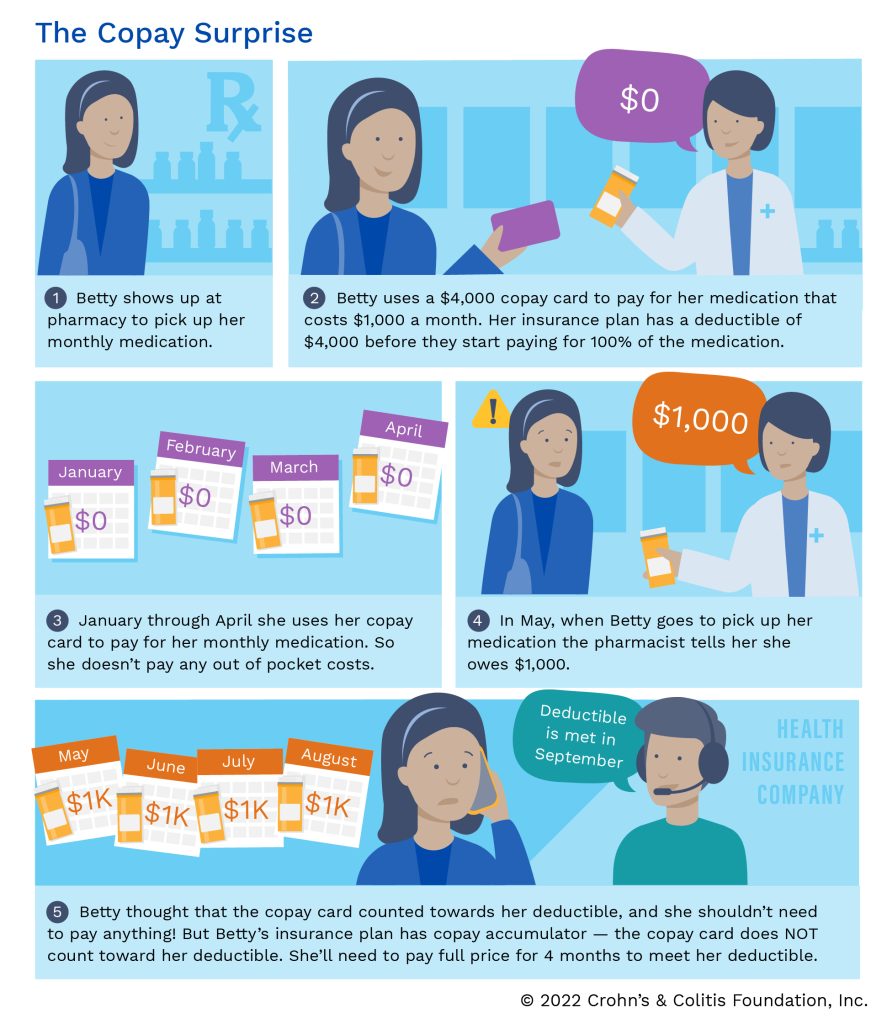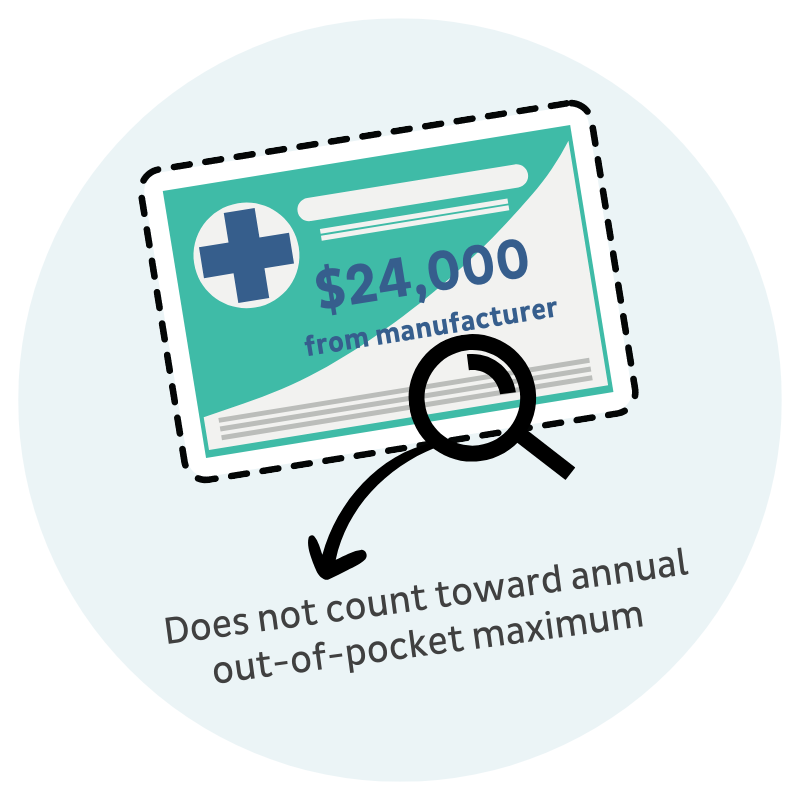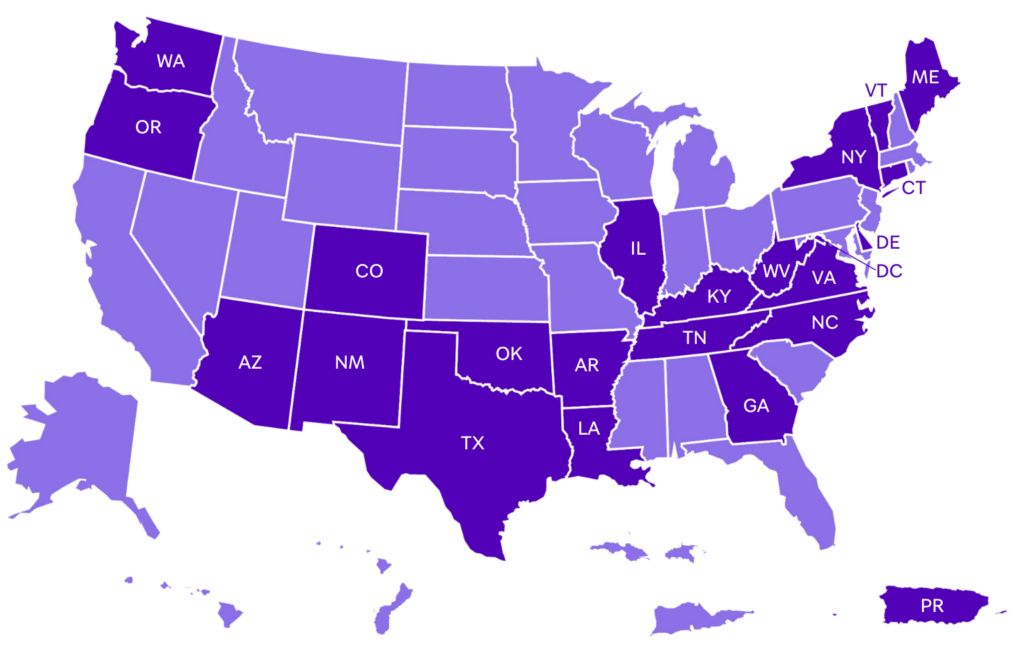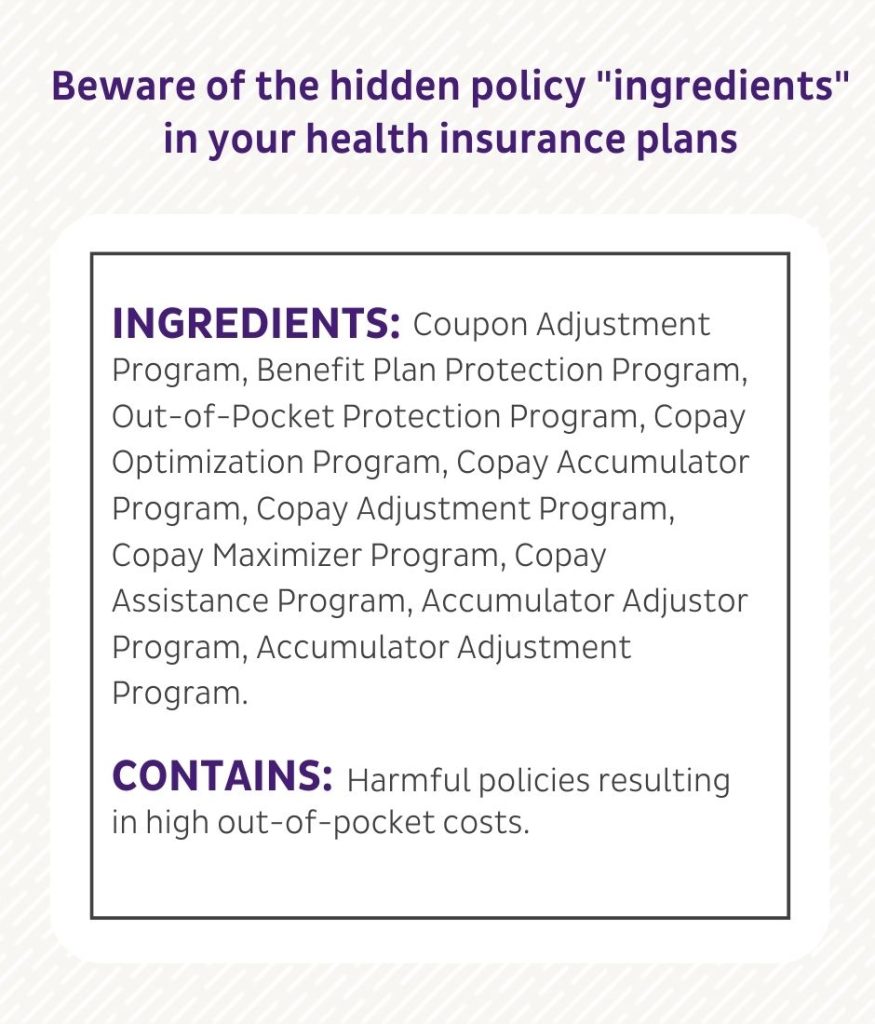Advocate with PAN to end these harmful programs for people with commercial insurance
Over the past several years, commercial health insurers have adopted programs and policies that limit access to medications and increase the out-of-pocket financial burden for patients living with life-threatening, chronic, and rare diseases.
Unfortunately, patients don’t usually know that these programs are part of their health plans. They often learn about the programs when they are at the pharmacy counter, and they are surprised by what they need to pay out of pocket to fill their prescription.
We invite you to learn about several of these harmful programs below, including copay accumulators, copay maximizers, and alternative funding programs. It is important that patients, as well as healthcare professionals, understand what these programs are, how they are preventing patients from adhering to treatment, and, most importantly, what steps they can take to advocate against them.
Please note: These programs can be found in commercial, or private, health insurance, like an employer-sponsored plan. They are not found in federal health insurance, such as Medicare.
Copay accumulators
What are copay accumulators?
Copay accumulators are programs implemented by insurance companies that affect how copay assistance is applied to deductible and out-of-pocket costs.
People living with serious illnesses are often prescribed medications with high out-of-pocket costs. Many patients find it challenging to afford these costs, which is why they often turn to financial assistance provided by pharmaceutical manufacturer programs, charitable foundations, friends and family, and faith-based communities. The value of this financial assistance typically counts toward the patient’s annual deductible or maximum out-of-pocket limit, as defined in their health plan.
But that isn’t the case for patients with health plans that have a copay accumulator program in place.
How copay accumulator programs work
Copay accumulator programs allow patients to use financial assistance to pay for the medication, but do not count any third-party contributions, like the value of a manufacturer coupon, toward the patient’s deductible or annual out-of-pocket limit. These programs are complex, so we’ve shared two scenarios below to help explain how they work.
For example, let’s consider a patient named Arthur, who is living with a chronic illness. Arthur has an annual deductible of $2,500 and a $500 manufacturer copay coupon for his medication.
- If Arthur’s plan does not have a copay accumulator program, the $500 coupon will count toward his annual deductible: $2,500 – $500 = $2,000. Arthur will be responsible for the remaining $2,000 before reaching his annual limit.
- If Arthur’s plan has a copay accumulator program, the $500 coupon will not count toward his annual deductible: $2,500 – 0 = $2,500. Arthur must pay the full $2,500 before satisfying his annual deductible.
When health plans include copay accumulator programs, patients pay more out of pocket for their treatment and take longer to reach their annual deductible and out-of-pocket limits.
The Crohn’s & Colitis Foundation shared a similar example of how copay accumulators work in the illustration below:

The impact of copay accumulators on patients
Unfortunately, copay accumulator programs are often put in place with little or no notice or education for patients. These programs negatively impact patients and remove an important safety net. Copay accumulator programs counteract financial support that is intended to help people afford their prescribed medications. They also disproportionately impact people who are seriously or chronically ill, particularly those with low-income and people of color.
The medications prescribed for these patients don’t often have generic equivalents. Faced with increased out-of-pocket costs, patients may choose not to start taking a medication at all, or to skip doses and not follow the treatment as prescribed by their health care provider. These programs can lead to poorer health outcomes and may add costs to the entire health system.
The Affordable Care Act provides minimum standards for coverage that protect people from high out-of-pocket costs, particularly for those with pre-existing health conditions. Copay accumulator policies ignore these protections.
What’s being done to protect people from copay accumulators
Every year, the Department of Health and Human Services (HHS) publishes the Notice of Benefit and Payment Parameters (NBPP) for the following year. This is a set of rules and guidelines for health insurance plans and issuers, like those available through the Affordable Care Act Health Insurance Marketplace or employer-sponsored coverage.
In April 2019, the HHS finalized the NBPP for 2020. which required insurers to count a patient’s copay assistance towards their annual deductible and total out-of-pocket cost.
But then, in 2021, the HHS introduced a rule allowing health plans to use copay accumulators. The 2021 rule overturned the 2020 regulation that had required health plans—with limited exceptions— to count copay assistance toward annual deductibles. This was a step backwards.
In 2022, 126 patient organizations, including PAN, united to oppose this rule. The group believed that the rule was illegal. And on September 29, 2023, the courts agreed, nullifying the 2021 rule by mandating that health plans include copay assistance in patient cost-sharing, effectively banning the use of copay accumulators by health plans. Unfortunately, while the courts ruled in favor of banning these practices, the rule has not been enforced by the federal government.
What the court ruling means for patients
Thanks to this court decision, as of September 29, 2023, all copay assistance should now count toward a patient’s deductible, coinsurance, copays, and annual cost-sharing limits.
The rule has one exception: it only applies to brand-name medications that have an equally effective generic equivalent. This means, if you opt for a brand-name medication that has a suitable generic equivalent, your copay assistance may not count towards your deductible and annual limit. However, if you have tried the generic and it wasn’t effective, then the copay assistance for your brand-name medication cost-sharing should count.
It is important to note that copay accumulators are not allowed for biologics or biosimilars.
Does this ruling mean copay accumulators are banned forever?
No, while this ruling is significant, until the federal government reinforces the guidance, many patients, particularly those on high deductible health plans or with high co-insurance, may continue to face challenges affording their out-of-pocket costs.
Ongoing advocacy efforts for more permanent solutions, like the Help Ensure Lower Patient (HELP) Copays Act, remain essential The HELP Copays Act would:
- Update the Affordable Care Act’s definition of cost-sharing to require that all out-of-pocket payments made by or on behalf of a patient count toward the patient’s deductible and out-of-pocket limit. This would end copay accumulator programs in marketplace exchange insurance plans.
- Stipulate that any item or service covered by an employer health plan is part of the essential health benefits package. Therefore, the plan must count any cost-sharing toward patients’ annual limits. This would end the Affordable Care Act’s essential health benefits loophole that allows plans to deem certain categories of drugs as non-essential.
Take action today
Contact your Congressional representatives and senators and urge them to push for comprehensive enforcement of the ruling and co-sponsor the HELP Copays Act (H.R. 830/S. 1375) if they haven’t already done so. The HELP Copays Act will update the Affordable Care Act’s definition of cost-sharing and ensure copay accumulator programs are banned.
Copay Maximizers
Understanding copay maximizers
When a health insurance plan has a copay maximizer program in place, they determine a patient’s prescription medication copay based on the maximum annual amount of pharmaceutical manufacturer copay assistance available—even if that amount exceeds the Affordable Care Act’s (ACA’s) maximum out-of-pocket requirements for essential health benefits. Plans then deem the patient’s specialty medication to be a non-essential health benefit, which means the plan will not cover it.

For example, let’s say that Ariel needs a specialty medication for her rare disease and there is $24,000 in manufacturer copay assistance available per year. Ariel’s health plan determines that her copay is at least $2,000 per month—$24,000 in available copay assistance divided by 12 months in the plan year.
Plans then notify patients that they can avoid high cost-sharing, like Ariel is facing in this example, by signing up for a copay maximizer program that applies manufacturer’s assistance to the patient’s prescription costs.
However, if a patient does not join the program and use the manufacturer’s assistance, they will be responsible for all the cost-sharing—even if it exceeds the Affordable Care Act limit.
Whether or not they use a copay maximizer program or self-pay, none of the payments will count toward their annual out-of-pocket maximum.
So, in Ariel’s example, she has two choices:
- She can join the copay maximizer program and use a manufacturer’s coupon to cover the $2,000+ monthly copay. She will have little or no upfront cost for her medication, but these payments will not apply to her annual out-of-pocket maximum.
- Or she can choose not to join the copay maximizer program and face the $2,000+ copay each month on her own. Her payments will not apply to her annual out-of-pocket maximum in this scenario either.
The impact of copay maximizers on patients
Copay maximizer programs may seem beneficial to patients because there aren’t up-front costs for prescriptions. But these programs hurt patients in the long run, because the payments that come from the manufacturer copay assistance program are not applied to a patient’s annual deductible.
Plans also require patients to enroll in maximizer programs separately. If a patient does not sign up, they may face significant out-of-pocket costs that exceed their plan’s out-of-pocket maximums. Their costs may also exceed the out-of-pocket maximums established by the Affordable Care Act.
Maximizer programs are also why some health plans are restricting access to essential health benefits, claiming that more and more specialty medications are non-essential and therefore do not have coverage. Non-essential health benefit schemes like copay maximizers violate the Affordable Care Act because specialty medications are prescription drugs and patient contributions for essential health benefits must count towards their annual out-of-pocket limits.
Like copay accumulator policies, maximizer programs disproportionately impact individuals who are seriously or chronically ill, particularly those with low-income and people of color. Faced with increased out-of-pocket costs, patients may choose not to start taking a medication at all, or to skip doses and not follow the treatment as prescribed by their doctor. This leads to poorer health outcomes.
More about essential health benefits
Prescription drugs are one of the ten essential health benefit (EHB) categories listed in the Affordable Care Act (ACA). While the ACA does not specifically define “prescription drugs,” it refers to prescription drugs broadly as FDA-approved drugs. Specialty medications are FDA-approved drugs, and they are usually the drugs prescribed to treat life-threatening, chronic, and rare diseases.
Health plans can adopt their own definition of EHBs, but their definition must be consistent with guidelines from the U.S. Department of Health and Human Services (HHS). To date, HHS has stated that plans can only exclude a name-brand prescription drug from coverage when the plan offers a generic alternative.
So that means when a health plan broadly categorizes specialty medications as non-essential health benefits without a generic alternative available, they are using an unauthorized definition of prescription drugs.
Non-essential health benefit schemes violate the ACA’s cost-sharing requirements
Under the Affordable Care Act (ACA), all essential health benefits, including prescription drugs, have annual limits on cost-sharing, unless an exception exists. Cost-sharing includes deductibles, coinsurance, copayments, and similar charges.
The HHS has also stated that if a patient pays for and receives a prescription medication that isn’t covered under the general health plan, the plan must consider this medication an essential health benefit and count the patient’s out-of-pocket payments toward the plan’s annual limit on cost-sharing. So, programs that prevent payments for specialty medications from counting towards a patient’s annual limits are not in compliance with the ACA’s cost-sharing requirements.
Legislation can ban copay accumulator and maximizer programs
Recently, we have seen interest at the state and federal levels in banning copay accumulator and maximizer programs.
To date, about one-third of all states and territories have passed legislation to ban these programs. They include: Arizona, Arkansas, Connecticut, Colorado, Delaware, District of Columbia, Georgia, Illinois, Kentucky, Louisiana, Maine, New York, New Mexico, North Carolina, Oklahoma, Oregon, Puerto Rico, Tennessee, Texas, Vermont, Virginia, Washington, and West Virginia.

In each of these states and territories, legislation requires insurers to count copay assistance paid by or on behalf of a patient towards their annual deductible and out-of-pocket maximum. This state legislation applies to state-regulated individual and family plans and fully funded small group health plans but does not apply to self-funded employer plans or large group plans. Unfortunately, state legislation does not stop plans from determining that items and services, like specialty medications, are non-essential health benefits.
At the federal level, bills have been introduced both in the House and the Senate.
H.R. 830, the Help Ensure Lower Patient (HELP) Copays Act, was introduced in February 2023 and requires health plans to count the value of copay assistance toward a patient’s cost-sharing requirements. The bill clarifies the Affordable Care Act definition of cost-sharing to ensure payments made “by or on behalf of” patients count towards their annual deductible and/or out-of-pocket maximum.
The legislation also states that any item or service covered under a plan is an essential health benefit and that cost-sharing for these items must count towards a patient’s out-of-pocket maximum.
H.R. 830 is championed by a bipartisan group of members of the House of Representatives, including Representatives Earl “Buddy” Carter (R-GA), Nanette Diaz Barragán (D-CA), Brian Fitzpatrick (R-PA), Diana DeGette (D-CO), Mariannette Miller-Meeks (R-IA), Bonnie Watson Coleman (D-NJ), and Yvette Clarke (D-NY).
The companion bill in the Senate, S. 1375, was introduced in April 2023 with bipartisan support from Senators Tim Kaine (D-VA), Roger Marshall (R-KS), Ed Markey (D-MA), and Joni Ernst (R-IA).
Three things you can do about copay accumulator and maximizer programs
#1 – Understand your policy
You should become familiar with your insurance policy documents and know if your plan includes a copay accumulator or maximizer program. People with employer-sponsored insurance plans, particularly people enrolled in high-deductible health plans (HDHPs), are most likely to have a copay accumulator or maximizer plan in their policy. HDHPs have become popular as employers and insurers try to lower their costs. When selecting insurance plans, it is important to understand your health plan’s deductible and your cost-sharing requirements.

Unfortunately, it can be quite difficult for patients to know if their plan has a copay accumulator or maximizer program in place—language differs from plan to plan.
These terms can all mean a plan includes a copay accumulator or maximizer policy:
- Copay accumulator (adjustment) program
- Copay maximizer program
- Benefit plan protection program
- Out-of-pocket protection program
- True accumulation
- Variable copayment
- Out-of-pocket maximum calculation
- Primary coupon adjustment
#2 – Become an advocate
Ask your elected officials to support The HELP Copays Act and ban copay accumulator programs. At PAN we have made it easy to send an email or call your members of Congress.
If you live in a state that has not banned copay accumulators:
- Contact your House representative
- Contact your state’s insurance department
- Tell your employer! It is possible that your employer may not be aware that they signed up for this program and may not realize the potential negative impact of the program has on their employees.
#3 – Share your story with PAN
If you have experienced the impact of a copay accumulator or maximizer program, we would love to hear from you. Your story helps others understand the impact of these programs.
Alternative funding programs
Understanding alternative funding and specialty drug carve out programs
Health plan sponsors, like employers that fund their own health coverage, may use alternative funding programs to save money by excluding some or all specialty medications from coverage, labeling them as non-essential health benefits. Since the health plan does not cover these specialty medications, a patient’s out-of-pocket spending will not count toward their annual deductible. Patients are then directed to alternative funding programs—also known as specialty drug carve out programs— operated by vendors that are separate from their health plan and are not health insurance.
These vendors work to connect patients with financial assistance through a drug manufacturer or charitable assistance program, disguising patients as uninsured, if necessary. Technically, these patients have no coverage for these medications. Vendors may even direct patients to illegally import medications internationally. But help paying for these medications is not guaranteed from any of these sources.
How these programs work:
- The patient is told that they must enroll in an alternative funding program and is referred to a private company, often called an alternative funding vendor. Vendors operate separately from the patient’s health plan.
- The vendor contacts the patient and offers to help find an assistance program to access their specialty medications.
- If the patient agrees to work with the vendor, the patient may be able to get their medication for little or no out-of-pocket costs if a patient assistance program is available and if the patient qualifies.
- The vendor collects the patient’s personal information, such as household size and annual income, to determine the type of third-party financial assistance the patient is eligible for.
- Vendors then determine whether patients are eligible for manufacturer copay assistance programs, charitable assistance programs, or international importation programs.
- The vendor helps patients disguise themselves as uninsured so they can apply for patient assistance programs to cover the cost of the prescriptions. (Keep in mind that while these patients have health coverage, their plan states that they are not covered for the specialty medications they need.)
- If no patient assistance program is available or if the patient fails to qualify, then the patient can be denied access to the medication or forced to pay out of pocket on their own. If assistance can’t be found or a patient can’t qualify, their health plan also has the option to override the original designation as a non-essential benefit, which allows the patient to resubmit a request for prior authorization for their specialty medications.
- If the patient refuses to work with the alternative funding vendor, then the patient will be denied access to the medication unless they self-pay.
- If the patient does not enroll, they will be responsible for 100 percent of the cost of the medication that is deemed non-essential. As a non-essential medication, any cost paid for the medication by or on behalf of the patient will not count towards their deductible or annual limit on cost-sharing.
- If the patient is eligible for a different program, like one that imports internationally, then the patient will receive their medication through that source. Some vendors will try to get products from pharmacies located outside the United States, but this is not permitted based on guidance from the Food and Drug Administration (FDA).
Access to specialty medications prescribed by health care professionals should be deemed an essential health benefit, and their costs should be covered by health plans. Patient assistance programs should be reserved for those who meet their specific eligibility criteria, based on need.
Legislation can ban alternative funding programs
Currently, there is no legislation pending that would prohibit the use of alternative funding programs. It is possible that there will be growing interest from Congress and the patient advocacy community stands ready to advocate to ban these harmful programs.
Three things you can do about alternative funding programs:
#1 – Understand your policy
If your plan has told you that your specialty medication is not essential, or that specialty drugs are excluded from the plan’s formulary and that another company can help you find financial assistance, then you may be involved in an alternative funding program scheme. When selecting insurance plans, it is important that you understand the health plan’s policy on including/excluding specialty medications on formulary.
#2 – Become an advocate
Let your elected officials know that alternative funding programs harm patients and should be abolished. Reach out to your members of Congress to share your story.
#3 – Share your story with PAN
As alternative funding programs become more common, one of the most important things we can do is track and share stories about how these programs are negatively impacting patient care. With alternative funding programs, patients face delays in their care and have the additional burden of sharing personal, financial, and medical information with external private companies just so that they try to find funding. If funding sources are not found, patients may have to delay starting their treatment, which could impact their health outcomes. If you have experienced an alternative funding program, we invite you to share your story.
-
Subscribe to news
Sign up to receive PAN news, from helpful articles to action alerts.
Subscribe today -
-